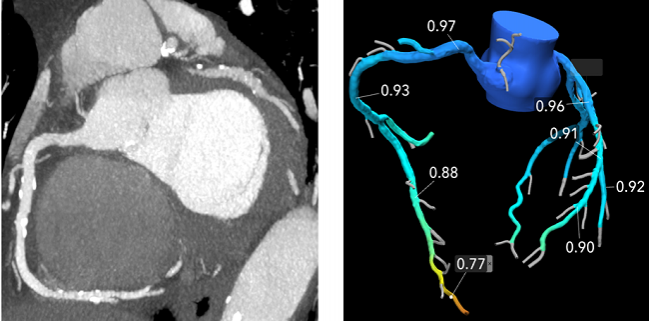Rapid-Access CT Model Seeks to Increase Efficiency, Reduce Delays for Chest Pain
The team is using a novel dedicated cardiac CT scanner to “get ahead of the guidelines,” says Jonathon Leipsic.

A team based at St. Paul’s Hospital in Vancouver, Canada, is trying out a new tactic that has successfully debuted in the United Kingdom—a model of rapid chest-pain rule out with a dedicated cardiac CT scanner as its centerpiece. The aim is to ease emergency room congestion and reduce delays in care..
“We're trying to get ahead of the guidelines,” Jonathon Leipsic, MD, who serves as the radiology department chair at St. Paul’s, told TCTMD. “Right now, too many patients get random care in a lot of centers depending on the referral patterns, and we're trying to just streamline it, make it more accessible, more timely, and more personalized and cost-effective.”
National Institute for Health and Care Excellence (NICE) guidelines in the United Kingdom currently recommend coronary CT angiography as a first-line test in patients without known CAD who present with chest pain, but guidelines in the rest of Europe and North America have been slow to follow suit. Leipsic argued there are “more and more data showing that CT is a really excellent first-line test for these patients with symptoms, and so we're trying to essentially lean the process.”
Following the SCOTHEART presentation last year, CT advocates are hopeful that the imaging test will move up in new US guidelines, due out later this year. Others, however, have advocated against increasing its use. Leipsic explained that his team started using the dedicated a CardioGraphe scanner (GE Healthcare)— a smaller than average machine that can fit into a reasonably sized clinic office room and was designed to capture the whole heart in one beat with what he said are “amazing temporal resolution” and an “excellent radiation dose profile.” In the past 6 weeks since they embarked on the project, they have already done more than 1,000 cases. One of the drivers behind adoption of this technology is cost, and he estimated that this particular machine is around 40% less expensive than a “traditional high-end CT scanner.”
Seeking ‘All in One’
Starting next year, his institution will launch their Rapid Access Cardiac Clinic, in which patients with chest pain symptoms can visit and receive a comprehensive cardiac work-up with CT. Rather than be referred to a cardiologist—and often need to wait for long periods—or take up unnecessary resources with an emergency room visit, the idea with the model is that patients are able to simply visit their clinic for a quick diagnosis.
“Based on basic algorithm and workup, they would then proceed for their CT the same day and then communicate the results back. [These] would either be no disease, you don't need anything [or] mild disease, you go for atherosclerosis management. And then more severe disease would go for [CT-derived fractional flow reserve, or FFRCT] and planned revascularization using a combination of CT and physiology from FFRCT to help plan the revascularization,” Leipsic explained. “[It’s] sort of all in one.”
This process should seamlessly fit into the Canadian healthcare model, he said, acknowledging that it might not be necessary in the United States, where Leipsic joked that some cities seem to “have a cardiologist every 10 feet.” The idea with the clinic is that a patient might not even need to see a cardiologist—rather they would be assessed first by a nurse practitioner, receive a CT scan, and potentially be discharged back to their family physician if no further intervention is deemed necessary.
The primary challenge is . . . making sure that patients are aware—getting the message out around the rapid-access clinic and making sure that people know that they don't have to go to [the emergency department] anymore. Jonathon Leipsic
“This is an exciting approach and an effective approach,” Leipsic said. “Now we just need to understand how we can make it more feasible, and I think there's a lot of ways that are going to make this possible.” Organizations like the Society of Cardiovascular Computed Technology offer valuable training, he said, and “purpose-built technology that's affordable and small and high end” will enable the new model to spread.
Additionally, tools like FFRCT will “allow even more personalization, which is I think going to be key,” he continued. “Right now, we've been sort of treating population-based risk, largely, and then [using] stress tests, which are not very sensitive for the person, the individual's disease burden, when it comes to nonsevere atherosclerosis.”
Introducing any new program isn’t easy, Leipsic acknowledged. “I think the primary challenge is really shifting the referral, making sure that patients are aware—getting the message out around the rapid-access clinic and making sure that people know that they don't have to go to [the emergency department] anymore—and also convincing our cardiology colleagues about just how streamlined we can make this,” he said, adding, “People have become big adopters of cardiac CT in Vancouver over the last 5 or 6 years, and I think this is just the next step as far as a more holistic approach.”
Looking to the future, Leipsic said his team is working on a registry with colleagues in Budapest, Hungary and Belfast, Northern Ireland who have also been using the CardioGraphe scanner.
Photo Credit: Jonathon Leipsic
Yael L. Maxwell is Senior Medical Journalist for TCTMD and Section Editor of TCTMD's Fellows Forum. She served as the inaugural…
Read Full BioDisclosures
- Leipsic reports serving as a consultant to HeartFlow and receiving a research grant from GE.


Comments